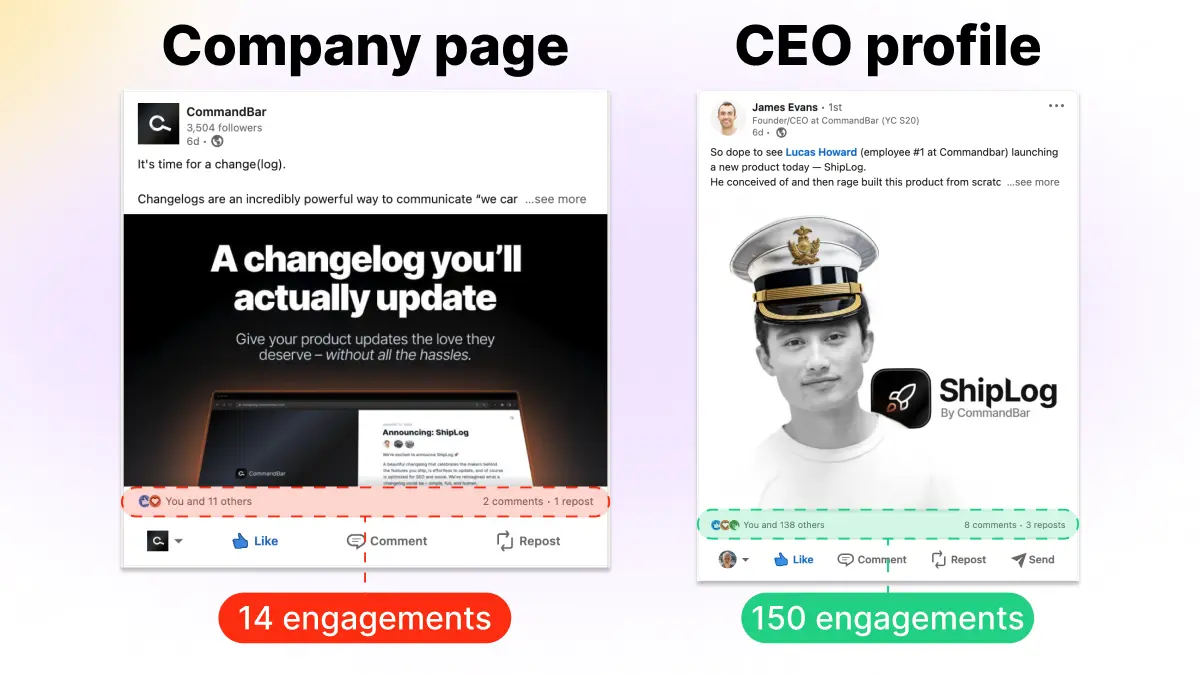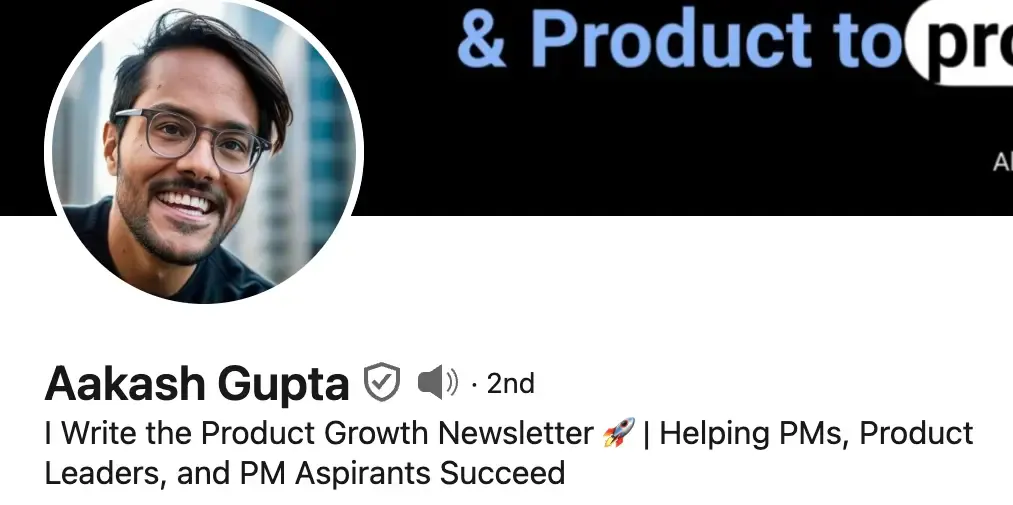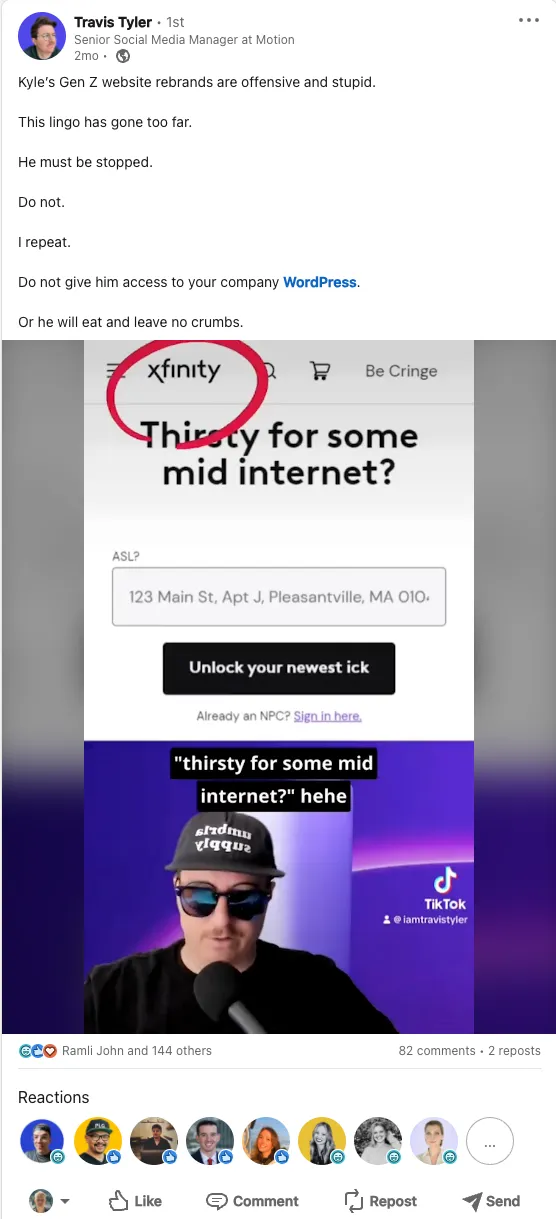In consumer products, creator/celebrity brands are one of the biggest trends. Logan Paul and KSI’s Prime drink reportedly does $1.2 billion in revenue. Mr Beast’s chocolate company Feastibles is a $200 million business. The right face can propel an undifferentiated product to billions in revenue.
Until recently, this trend spared the software industry, with notable exceptions (Tobi Lütke at Shopify, Jason & David at Basecamp). Now it feels like many founders spend more time talking to LinkedIn than talking to users.
Engineering purists might call this a waste of time. But it’s one of the few high-upside channels left: Company pages are pay-to-reach and SEO is a bloodsport. Look at this:

The announcement of the exact same thing received more than 10x the engagement. Sure, the framing is different. But imagine how big the difference is!
That’s why LinkedIn is filled with founders and creators sharing their stories, perspectives and advice. A post that could’ve been written in an airport Uber summons customers on demand—while you’re asking strangers to “Hop on a quick call”.
It’s easy to be jealous. But none of these founders logged into LinkedIn one day to find they’ve been awarded an audience that knows, likes and trusts them. They’ve built it from the ground, starting small and growing big.
I know because I’ve spent the past weeks analyzing those founders. I’ve scrolled for miles to find their first, posts and traced them back to today. Here’s what I learned—and how you can build a following on LinkedIn to get new customers:
What are you optimizing for?
Before we start with tactics, let’s clarify something: If you copy someone’s strategy (well), make sure you want the same thing.
Let’s take an example. I’m on CommandBar’s marketing team. My goal: Get customers for CommandBar.
As one of my favorite podcast guests, I was excited to research Elena. I was impressed with her 95,000 follower audience, but disappointed with her content: It seemed so boring—Memes, viral videos with tech-related captions… That wasn’t the insightful Elena I’d listened to on podcasts!
I almost dismissed it as a fluke: A creator who used to be good, but now just chases whatever gets the most likes. Nothing to learn here. But a single post turned that perception around:

I was wrong! Her content doesn’t lack tactics & opinions on SaaS because it’s bad—it’s that she doesn’t aim to get SaaS customers!
To grow her Substack, she wants to maximize attention. Posting memes that get attention broadens her top-of-funnel and creates more subscribers. She accumulates LinkedIn followers because those trickle down into Substack.
Her strategy would look different if she was leading growth at a Series A startup like CommandBar. Then she would’ve needed to tell more stories, share more tactics and focus more on showcasing specific expertise than broad reach. It would’ve been easy to think “Well, she has 95k followers and I have 1.5k so I better start posting memes!”. I might’ve ended up with more followers, but no extra leads.
The above is a simplified model—in reality, doing this well will looks like an indifference curve where you’ll gain followers, engagement AND trust, but need to define how much you want of each.
Before you steal borrow any tactics, makes sure those tactics support the strategy you pursue. Make sure this doesn’t become you:

The audience size of big creators is inspiring, but always work backwards from what you want, not what they have. If what they do doesn’t align with that, don’t copy it!
Note: For the rest of this post, I’ll keep using follower & engagement counts as success metrics. That’s because those metrics are visible while leads, customers, etc. aren’t.
Okay, let’s figure out what I found:
Call out your people
There’s a temptation to create for everyone. Bigger TAM = bigger chance for your post to resonate with any given person, right? No!

Most creators used a typical startup strategy: Find a market wedge, then expand from there. Aakash Gupta makes crystal-clear who it’s for: PMs, product leaders, PM aspirants. And it’s not just him:
- Lenny Rachitsky created specifically for product managers, a group that many in tech didn’t pay much attention to (or even detested).
- Elena Verna posted about marketing teams feeling neglected in engineering-dominated tech companies. She also advocated for women/mothers in tech.
- Anthony Pierri positioned himself (/his agency Fletch) specifically for product marketers in vertical B2B SaaS startups.
- Enzo Avigo (founder of june.so) brands himself as the “pre-PMF product management guy”.
These were initial wedges, often followed by expansions. An example is Lenny Rachitsky, whose content now includes general tech career advice, growth strategies and more.
Never stop posting (even when nobody cares yet)
Startup founders, agency owners, full-time creators—everyone I studied had one thing in common: Posting regularly for years, even when engagement was low.
The “10 year overnight success” is a cliche. It’s also true. Elena Verna has been posting for 7+ years. Aakash Gupta (now at 198k followers) started 2 years ago. Kyle Poyar, now at about 40,000 followers, started posting 8 years ago.
That doesn’t mean breakout successes don’t happen: Anthony Pierri’s first “explainer image” post received 600+ engagements. Following this, he also had many troughs where engagement was low.
Step function growth is the only (real) growth
If consistency was all that mattered, growth would be linear: Get a few followers each day. Then, even without any breakout hits, you’ll grow the following you want.
But that’s not the case: In my research, the 80/20 principle always applied. Most of the engagement happened on outlier posts, which raise raised the baseline of non-outlier posts.
Algorithms suppress what doesn’t get engagement, ensuring you never see those people’s average posts. Of the tens of thousands of posts I saw, most got average or even bad engagement. But breakout posts redefine average and bad.
A viral post can get you so many followers that an average post then gets higher engagement. Since viral posts are unpredictable, that doesn’t mean you can skip the consistency. But you can give yourself a better chance:
High-engagement LinkedIn posts: 5 stealable tactics
It’s impossible to predict which posts go viral. But it’s easy to know which likely won’t. You can think about it like a software product: You never know which app will take off.
But if an app has no social/collaboration features, sharing or invites, its chances of going viral are tiny (yes, there are exceptions).
The same is true for social posts. Here are 5 formats I’ve seen work often:
1. Involve others in your posts
The same way an app is more likely to go viral if people use it together, your post is more likely to get attention if it involves more people than you. This is because people you tag will get a notification. If they engage, the post will be shown to more people.
A great example is Anthony Pierri’s breakout post (way before he had 40k followers). He tags 7 people and/or companies!

He got attention from a ton of people. And it’s likely that some of these high-profile people engaged with it. The origin is deeply human: If others are talking about you, you want to know what they're saying. That doesn’t mean you can just tag your way to virality. Many might be too busy to engage even with posts that directly compliment them!
But how much less engagement would Anthony have gotten had he only posted the Miro board?
2. Hot takes!
Taking the opposite side of a common argument gets people’s attention. Many tech founders or other entrepreneurial people have renegade opinions that run counter to conventional wisdom.
If you have some, share them!

This got attention because most people tell each other they need to charge more. Anthony takes the opposite point of view.
A few notes on this tactic:
- Use it sparingly: Nobody likes the person who always complains.
- Only do it when you believe in it: Short-term follower growth isn’t worth compromising trust.
- Make a good point: You should be able to back up your point, as Anthony does with his story.
3. Do what others are afraid of
Many people are afraid to look ridiculous in a business context. Travis Tyler isn’t. He creates TikTok-style skits on LinkedIn:

In this specific skit, he rewrote Xfinity’s landing page with Gen Z lingo. Note that this isn’t only funny, but also showed a great command of copywriting!
This is certainly not for everyone (and won’t get you a promotion of McKinsey), but works well for him. If you’re willing to go further than anyone else, go there!
4. Tell your story (if it’s good)
LinkedIn is awash with people talking about what someone could, should, would do and dispensing advice they’re not taking. Everybody knows this.
Imagine a post that said “It’s worth taking a pay cut if it’s for doing what you love!”. Generic, read-right-past-it.
Enzo Avigo (and many other smart creators) do the opposite:

He tells his story and has skin in the game. If you have interesting stories to tell, this is far more interesting than giving advice. We love to see people share what they’ve done, not what they might do.
The right stories also build trust in you and give you depth, which makes people more likely to engage with you.
5. Summarize complex topics in one image
Kyle Poyar often creates “cheat sheets”, which summarize complex topics like SaaS growth in a single image:

This makes your content feel incredibly valuable and makes readers feel like they’re getting a ton of value in one post instead of cobbling the knowledge together from reading tons of blogs and social media accounts.
It also leads to people being more likely to screenshot/download your content and sticking around, which is a positive signal to social media distribution algorithms.
I’ll see you in my feed!
Alright, we’ve just discussed a lot principles, strategies and tactics—from abstract to actionable. I hope you put them into practice and go so viral you show up on my feed soon.















